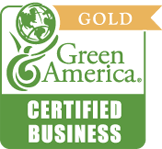
A member of Green America since 2000, American College of Healthcare Sciences (ACHS) and the Apothecary Shoppe College Store have been re-certified as Green America Gold Certified Businesses.
Green America’s vision is to “work for a world where all people have enough, where all communities are healthy and safe, and where the bounty of the earth is preserved for all the generations to come.” ACHS supports this vision through the College mission and partnerships with dedicated organizations like Green America.
“We’re thrilled ACHS has been re-certified with Green America’s highest honor, the Gold Seal, for our dedication to providing leadership in holistic health education through comprehensive professional online and on-campus education and high-quality natural products with a commitment to sustainable practices and principles,” says ACHS President Dorene Petersen. “A big thank you to our students, alumni, and Apothecary Shoppe customers for supporting ACHS and for supporting other Green America members.”
To display the Green America Green Business Certification Gold Seal of Approval, ACHS successfully met Green America’s stringent green business requirements. The Green Business Certification is awarded to businesses that are actively using their business as a tool for positive social change, operating a “values-driven” enterprise according to principles of social justice and environmental sustainability, and environmentally responsible in the way they source, manufacture, and market their products and run their operations and facilities. (You can find a complete list of business standards at http://www.greenamerica.org/greenbusiness/)
Learn more about ACHS’s commitment to sustainability online at http://www.achs.edu/achs-green-campus and view ACHS’s sustainability profile, green achievements, and commitments in the National Green Pages online here: http://www.greenpages.org/listing/guide/education
About ACHS
American College of Healthcare Sciences was one of the first accredited colleges offering degrees, diplomas, and career-training certificates in complementary alternative medicine fully online. Founded in 1978, ACHS is committed to exceptional online education and is recognized as an industry leader in holistic health education worldwide. For more information about ACHS programs and community wellness events, visit www.achs.edu, call (503) 244-0726, or stop by the College campus located at 5940 SW Hood Ave., Portland OR 97239.
>> GO TO www.achs.edu to read the full article on the American College website under News and Events. Or click here.




